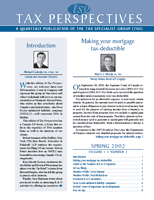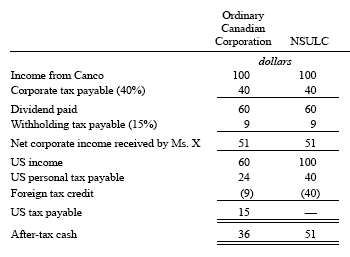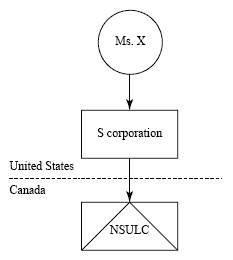
PDF Format
 Issue Contents Issue Contents
 All Issues All Issues
Spring 2002
Volume 1, Number 3
The information in Tax Perspectives is prepared for general interest only. Every effort has been made to ensure that the contents are accurate. However, professional advice should always be obtained before acting on the information herein.
Nova Scotia Unlimited Liability Companies
By Steven Peters, CA, CPA, TEP
Steven Peters Limited (Halifax)
It is often said that tax is the world of the strange and bizarre. But who would have thought that the failure of Nova Scotia to modernize its corporate legislation would create a US taxplanning opportunity? Nova Scotia is the only province to contain a vestige of archaic English corporate law that allows shareholders to elect to have unlimited liability for corporate debts. This unlimited liability causes a company making this election, a Nova Scotia unlimited liability company (NSULC), to be treated as a "flowthrough" entity for US tax purposes— a disregarded entity if it has only one shareholder and a partnership otherwise. Either way, the US shareholder of the NSULC reports its share of the NSULC's income and expenses directly on its US tax return. An NSULC is still treated as a corporation for Canadian tax purposes. It is thereby eligible for the Canadian tax benefits accorded Canadian corporations, such as tax-free reorganizations, the small business deduction, and refundable taxes on investment income. This hybrid status—a flowthrough entity for US purposes but a corporation for Canadian purposes—provides a number of advantages,  which have made the NSULC one of the most powerful tools in Canada—US cross-border tax planning. Two of these advantages will be discussed in this article, and additional points will be explored in a sequel. which have made the NSULC one of the most powerful tools in Canada—US cross-border tax planning. Two of these advantages will be discussed in this article, and additional points will be explored in a sequel. FOREIGN TAX CREDIT The primary benefit of an NSULC to a US individual investor is that it allows a foreign tax credit on the investor's US tax return for the Canadian corporate income tax of the NSULC, thereby avoiding double taxation. Let's consider the scenario of Ms. X, a US citizen who intends to carry on a business venture in Canada through a Canadian corporation (Canco). Because it is not Canadian-controlled, Canco will be subject to Canadian corporate income tax at the high rate. We will assume that Ms. X will be subject to US income tax at the highest marginal tax rate. If an ordinary Canadian corporation is used, Ms. X will pay US income tax on dividends received, but will not receive any foreign tax credit for Canco's corporate income tax. As a result, the total tax burden after all profits have been distributed to her will be a rather depressing 64%. In contrast, if Canco is an NSULC, Ms. X's ability to claim a foreign tax credit for Canco's corporate income tax will reduce the total tax burden to approximately 49%—thereby increasing her after-tax income from $36 to $51 for every $100 earned by Canco! LOSS FLOWTHROUGH Another potential benefit to Ms. X is that losses of the NSULC may, subject to certain constraints, flow through and be deducted on her US income tax return. This flowthrough is a timing benefit if the NSULC turns around and becomes profitable in the future, or could become a permanent benefit if the NSULC is ultimately wound up at a loss. If an ordinary Canadian corporation had been used, the loss on liquidation would be a capital loss, which may be used by Ms. X only against capital gains. STRUCTURING TO INSULATE FROM LIABILITY As noted above, the shareholders of an NSULC have unlimited liability for corporate debts. This liability arises if the NSULC has insufficient assets to meet its obligations on winding up. To protect the shareholders from this liability, a US corporation would normally be interposed between the US shareholder and the NSULC as a holding company. In this scenario, the holding company would be an S corporation, which, like an NSULC, is treated as a flowthrough entity for US tax purposes. The S corporation also serves to reduce the Canadian withholding tax rate on dividends paid by the NSULC from 15% to 5%, increasing the net retention from 51 to 57%. This structure is illustrated above. Existing corporations can be converted to NSULCs on a rollover basis for Canadian tax puposes. Such conversion can be advantageous in advance of bringing in a new shareholder who is a US taxpayer. However, the conversion will be taxable as a liquidation for US purposes, triggering accrued gains if the corporation already has a US shareholder. This highlights the importance of proper planning at the outset of a business venture. My technical paper on NSULCs is available here.
|